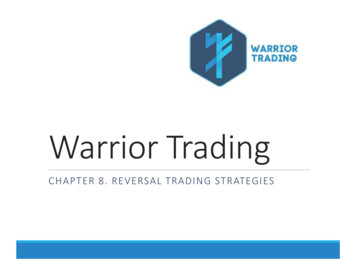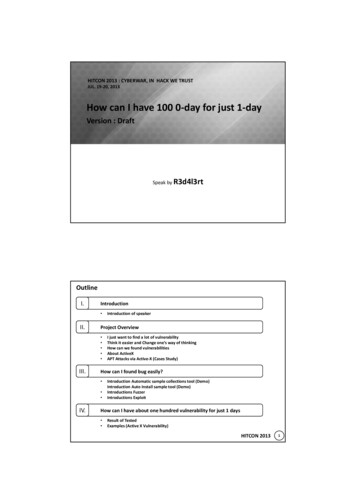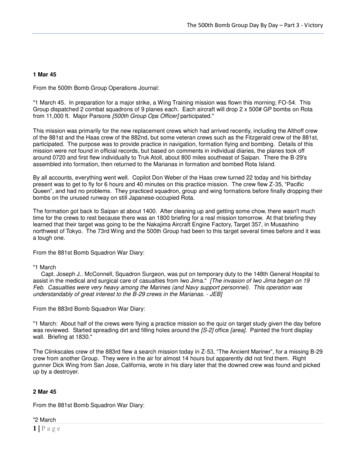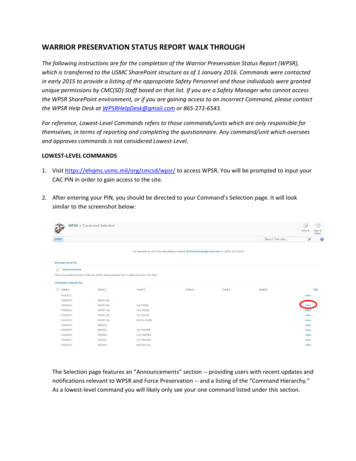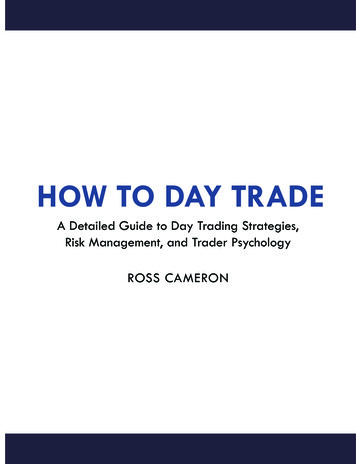
Transcription
HOW TO DAY TRADEA Detailed Guide to Day Trading Strategies,Risk Management, and Trader PsychologyROSS CAMERON
AuthorHouse 1663 Liberty DriveBloomington, IN 47403www.authorhouse.comPhone: 1 (800) 839-8640 2015 Ross Cameron. All rights reserved.No part of this book may be reproduced, stored in a retrieval system, ortransmitted by any means without the written permission of the author.Published by AuthorHouse 05/03/2018ISBN: 978-1-5049-5772-4 (sc)ISBN: 978-1-5049-5773-1 (e)Library of Congress Control Number: 2015917812Print information available on the last page.This book is printed on acid-free paper.Because of the dynamic nature of the Internet, any web addresses or links contained in this book may have changedsince publication and may no longer be valid. The views expressed in this work are solely those of the author and do
CONTENTSIntroduction. viiChapter 1Why do most traders fail? . 1Chapter 2Risk Management . 6Chapter 3Stock Selection - Choosing the right stocks to trade .12Chapter 4Introduction to Candlesticks .23Chapter 5Setting Up Your Charts - Technical Indicators.29Chapter 6Support and Resistance .43Chapter 7Order Types, Level2, Time & Sales, Hotkeys .53Chapter 8Trend (momentum) Trading Strategies .64Chapter 9Counter Trend (reversal) Trading Strategies .95Chapter 10 Stock Scanning & Building a Watch List . 104Chapter 11 Three Step Day Trading Plan .111Conclusion .115Biography .117
Dedication to Mom, Dad, Lisa and Lauren. Thank you for your love, support,and understanding. You keep me focused, driven, and happy.
INTRODUCTIONSuccess as a day trader will only come to 10% of those who try. It’s important to understandwhy most traders fail so that you can avoid those mistakes. The day traders who lose moneyin the market are losing because of a failure to either choose the right stocks, manage risk,nd proper entries, or follow the rules of a proven strategy. In this book I will teach youtrading techniques that I personally use to pro t from the market. Before diving into thetrading strategies we will rst build your foundation for success as a trader by discussingthe two most important skills you can possess. I like to say that a day trader is two things,a hunter of volatility and a manager of risk. I’ll explain how to nd predictable volatility andhow to manage your risk so you can make money and be right only 50% of the time. Weturn the tables by putting the odds for success in your favor. By picking up this book youshow dedication to improve your trading. This by itself sets you apart from the majority ofbeginner traders.The act of day trading is simply buying shares of a stock with the intention of selling thoseshares for a pro t, within minutes or hours. In order to pro t in such a short window of time,we trade shares of companies that have just released breaking news, made a big earningsannouncement or have any type of fundamental catalyst that results in above average interestfrom retail traders and investors. The type of stocks a day trader will focus on are typicallymuch different from what a long term investor would look for. Day traders acknowledge thehigh levels of risk associated with trading volatile markets, and they mitigate those risks byholding positions for very short periods of time.While investors typically look for 5-10% annual returns, day traders look for trades thathave the potential to make 5-10% intraday returns. However, in order to pro t from intradaymoves, most day traders will take large positions which can result in a high level of singlestock exposure. Some will even engage in the high risk practice of trading on margin (moneyborrowed from your broker). For example, a day trader with a 25k trading account may usemargin (buying power is 4x the cash balance) and trade as if he had 100k in equity. Thisis considered leveraging your account. By aggressively trading on margin, if the trader canproduce 5% daily returns on the 100k buying power, the trader will grow the 25k initialequity at a rate of 20% per day. The risk of course is that the trader will make a mistake thatcan cost him everything. Unfortunately, this is the fate for 9 out of 10 traders. The cause ofthese career ending mistakes result from a failure to manage risk.Imagine a trader who has just taken 9 successful trades. In each trade there was a 50 riskand 100 pro t potential. This means each trade had the potential to double the risk for a2:1 pro t loss ratio. The rst 9 successful trades produce 900 in pro t. On the 10th trade,when the position is down 50, instead of accepting the loss, the untrained trader purchasesmore shares at a lower price to reduce his cost basis. Once he is down 100, he continuesto hold and is unsure of whether to hold or sell. The trader nally takes the loss when he isdown 1k. This is a trader who has a 90% success rate, but is still a losing trader because hevii
ROSS CAMERONfailed to manage his risk. We will discuss in detail how to identify stocks and nd good tradeopportunities, but rst we will focus on developing your understanding of risk management.Traders that don’t utilize risk management techniques stand a good chance of being amongthe 90% of retail traders who lose money in the market.Over my years as a trader and as a trading coach, I have worked with thousands of students.The majority of those students experienced a devastating loss at some point due to avoidablemistakes. It is easy to understand how a trader can fall into the position of a margin call (adebt to your broker). The money to trade on margin is easily available, and the allure ofquick pro ts can lead both new and seasoned traders to ignore commonly accepted rulesof risk management. The 10% of traders who consistently pro t from the market share onecommon skill. They cap their losses. They accept that each trade has a predetermined level ofrisk and they adhere to the rules they set for that trade. This is part of a well-de ned tradingstrategy. It’s common for an untrained trader to adjust their risk parameters mid-trade toaccommodate a losing position. For instance, if they said their stop loss is at - 50, and thetrade goes down to - 60, they might say they’ll hold for just a few more minutes to see if itcomes back up. Before you know it, they are looking at an 80-100 loss, or worse, and theyare wondering how it happened. I’ll admit that it’s extremely dif cult to achieve the levelof discipline to sell when you hit your max loss on a trade. Nobody wants to lose, but thebest traders are great losers. They accept their losses with grace and move on to the nexttrade. They never allow one trade the ability to destroy their account or their career. Thischaracteristic will keep them in business as a day trader for a long time.The skill to take losses and not allow them to cause you to lose focus is an act of mindfulness.Our human emotions often work against us while we are in trades. The emotions of fearand greed are present in every trader. The successful traders are able to experience thoseemotions without acting on them. When you allow emotions to overtake your rationalthought process, you run the risk of over trading, exposing yourself to unnecessary risk, andunplanned losses. It takes years of emotional conditioning to be able to sit for eight hourswatching the computer screens while maintaining composure the whole time. For new traders,we encourage starting with shorter blocks of time and maintaining a constant focus on theidea of thinking like a risk manager.Buying Long or Selling ShortIf you are new to trading you may not be familiar with the concept of selling short. Traderswho sell short are borrowing shares from their broker to sell those shares at a high price, withthe intention of buying the shares back at a lower price, and pro ting from the drop. Whenyou sell short, your account will show in your open positions window, a negative position(e.g. -1000 shares). You have borrowed 1000 shares from your broker and sold them. Thebroker expects that you will buy back those shares. When you buy back those shares, it iscalled covering your position. Some traders have a short bias and prefer to trade as stocksdrop. One of the risks with short selling is that if the stock goes up, you will eventually beviii
H O W T O DAY T R A D Eforced to cover your position. Since theoretically prices can climb in nitely, a trader couldexperience an in nite loss if they do not cover their open short position.Conversely, when you buy stock to the long side, your maximum loss is capped to the amountof shares you purchased. The worst case scenario is the stock goes to 0. With a shortposition, if you short 1000 shares of a stock at 5.00, and it goes up to 100.00, your 5kposition becomes a 95k loss. Throughout this book, we will discuss examples of momentumtrades that involve buying stock to the long side, but these patterns could be equally appliedto the inverse pattern in order to short stocks.Whether you are a short seller or a long biased trader, it is important to know about the ShortSale Restriction (SSR). This was designed to reduce downward volatility and help preventpotential stock crashes. When Short Sale Restriction has been activated on a stock, you canonly short the stock when the price is moving up. This prevents people fueling a crash byshorting as the price is dropping. SSR is turned on when a stock drops more than 10% inprice versus the previous days close. The SSR is an example of an indicator that tells us themarkets have a built in bias for trading to the long side. There is no such thing as a long buyrestriction. A stock can surge up 100% and you can continue to buy as it surges. This is oneof the reasons I prefer to be a long biased trader.It’s also important to note that shorting is not available for all stocks. The ability to short astock requires your broker to have shares available to borrow. If they have a small inventory,you may not be able to short that stock.What you will learnIf you have tried day trading or watched somebody else day trade, you already know theconcepts are simple, but being successful at day trading is like walking a tightrope. If you watchsomebody doing it they make it look easy, but when you try it, it seems nearly impossible.This is the experience most new day traders will go through. In fact, it’s the same experienceI went through when I was learning to trade. I have found that the best trades are the onesthat have the most obvious setups and start to work in our favor almost immediately. If I ndmyself in the position of holding trades that aren’t performing or I start trying to force tradesto work under less than ideal setups, I usually get into trouble. I’d encourage traders to focuson the obvious setups we teach rather than overcomplicating things.In this book we will teach you the fundamental concepts required for day trading. You willlearn how to manage risk, how to choose stocks worth trading, how to identify potentialsetups, how to enter and exit trades, and how to manage your emotions while you aretrading. By taking the time to educate yourself, you are already proving a willingness tolearn, and that puts you ahead of the majority of new traders. Most new traders will tradeunproven strategies and then wonder why they are losing money. While you are in training,it is important that you only trade in a simulated account. You have to practice the strategieswe teach and work on building your skills before ever trading in a live account. In our livetrading courses, we review the performance of all our students to ensure they are meeting theix
ROSS CAMERONmetrics and statistics of a pro table trader. This means we evaluate accuracy rates, averagelosses versus average winners, how much risk they take in their trades and how they behaveunder stress of dif cult markets or losing positions. Once students have proven they can bepro table in a simulated environment, they will be ready to switch to live trading with strictsize and risk restrictions. Students in our live day trading chat room bene t from being ableto trade side by side with me, and hundreds of other professional traders. We have trainedthe students in our community to be the best possible traders, thus increasing the overallskill of our trading group.x
CH A P T E R 1WHY DO MOST TRADERS FAIL?If you are considering a career as a day trader, you cannot ignore the statistics that show only1 in 10 traders will be able to make a living at it. I am not saying this to discourage you fromtra
trading strategies we will À rst build your foundation for success as a trader by discussing the two most important skills you can possess. I like to say that a day trader is two things, a hunter of volatility and a manager of risk. I’ll explain how to À nd predictable volatility and how to manage your risk so you can make money and be right only 50% of the time. We turn the tables by .File Size: 1MBPage Count: 52Explore furtherGuide to Effective Daytrading - Precision Trading Systemwww.precisiontradingsystem.comTop 10 BEST Forex Trading Strategies PDFwww.forexstrategieswork.comPRICE ACTION TRADING - ThinkMarketswww.thinkmarkets.comThe Secrets of Trading The First Pullback: A Price Action .1.droppdf.comRecommended to you based on what's popular Feedback


